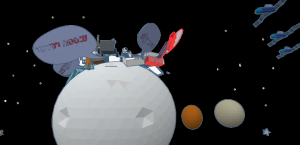Registrations are closed
In the future, to enable astronauts to stay on the Moon for long periods of time, new infrastructures must be developed to overcome important challenges. Such challenges include protection from radiation and meteorites, energy production, the extraction and recycling of water, food production and much more. The Moon Camp Challenge invites students to explore the Moon and decode some of the complexities future astronauts may face.
In Moon Camp Discovery each team’s mission is to 3D design only one component of a Moon Camp using Tinkercad. Teams can choose to design a:
– Lunar lander
– Moon Base
– Lunar rover
– Rocket
– Lunar Orbital Space Station
The design should be adapted to the Moon environment and if possible consider the use of local resources, provide protection and/or living and working facilities for the astronauts.
Moon Camp Discovery is a non-competitive mission for beginners. All teams that submit an entry that complies with the guidelines will receive a participation certificate and their project will be shared on the Moon Camp online platform.
Who can participate?
Participation is open worldwide to students aged up to 19 years old. Moon Camp Discovery is recommended for students aged 6 to 14 years old. Participating students must be supported by a teacher, educator or parent.
Discovery Projects Gallery 2020-2021
Below you can find some of the Moon Camp Discovery projects. For more projects visit the Moon Camp Discovery project gallery.
Team: mariem abdelmoula
sfax Tunisia Category: Moon base
External link for Tinkercad 3D design
energy!
An energy source that contains almost all the materials needed to build solar panels. Energy source: Flowing temperatures between 156 minus 121 plus
Especially for the extraction of oxygen and water by robots
1 The task is to create breathable air. Surprisingly, this is fairly easy because moon soil contains 42% oxygen, heat and electrical energy. This oxygen can be harvested by robots.2 2/3 hydrogen 1 /3 oxygen offers plenty of the first ingredient it does exist on the nasa confirmed
Surface in ice form rovers could find drill and gather this ice settlers would use this water fir drinking
(we can extract oxygen and hydrogen for rocket fuel)
3 (food) how we can plaint tree on the moon to got food it ‘s good that the soil of moon very sand that would rapidly erode away from plan’ t roots
But it also contains lots of toxic metals and other compounds harmful to plant grouwth
However, the experiments are here on earth with soil that mimics the mother
Lunar Dirt has shown promise by adding human manure to the soil that binds minerals and toxic compounds with nutrients and helps retain water. The only element a lunar settler needs from Earth is seeds and earthworms that restore organic matter to them and improve soil structure, making them pivotal in creating a sustainable lunar agricultural ecosystem
















